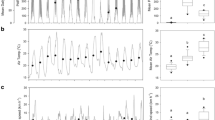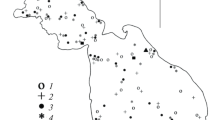Abstract
Ten variables were measured at least twice per month at three locations of Lake Tanganyika (East Africa) over one year (1993–94). Upwelling was observed in the south of the lake during the dry, windy season from May to September. Stratification was variable in strength but always present in the north. The lake showed a marked tilting of the epilimnion during the dry season (0-20 m in the South, 60–70 m in the North). This period was followed by oscillations of water masses towards an equilibrium when the strong winds from the south east ceased. Conductivity and pH fluctuations indicated dampened oscillations, particularly at the ends of the lake. Movements of the epilimnion toward an equilibrium position generated and/or re-inforced internal waves. These waves were inferred from fluctuations of chemical and physical characteristics of the lake. The concentrations of inorganic P and N commonly fluctuated by a factor of 3 or more in the epilimnion. The period of long-period internal waves was estimated to be ca. 28–33 days. Turbidity changes suggested pulse production caused by internal waves linked to non-random patchiness in nutrients and organisms. Turbulence resulting from highly dynamic physical events also induce random-patchiness in water composition. The lake water generally showed oligotrophic characteristics near the surface but had high concentrations of nutrients in deep water. The results showed that the trophic state of Lake Tanganyika, like that of the oceans, seems to depend largely on regeneration processes. The annual limnological cycle in Lake Tanganyika appears closely linked to the climatic conditions.
Similar content being viewed by others
References
Beauchamp, R. S. A., 1939. Hydrology of Lake Tanganyika. Int. Rev. ges. Hydrobiol. Hydrogr. 39: 316–353.
Coulter, G. W., 1968. Hydrological processes and primary production in Lake Tanganyika. Proc. 11th Conference Great Lakes Res. Int. Ass. Great Lakes Research: 609–626.
Coulter, G. W., 1991. Lake Tanganyika and its life, Oxford University Press. London Oxford & New York: 354 pp.
Coulter, G. W., 1994. Lake Tanganyika, In K. Martens, B. Goddeeris & G. Coulter (Eds), Speciation in Ancient Lakes. Arch. Hydrobiol. Beth. Ergebn. Limnol. 44: 13–18.
De Bont, A. F., 1972. La productivité du Lac Tanganika. Verh. int Limnol. Verein 18: 656–660.
Dubois, J. Th., 1958. Evolution de la température, de l' oxygène dissous et de la transparence dans la baie nord du Lac Tanganika. Hydrobiologia 10: 215–240.
Haberyan, K. A. & R. E. Hecky, 1987. The late Pleistocene and Holocene stratigraphy and paleolimnology of Lakes Kivu and Tanganyika. Palaeo-3, 61: 169–197.
Hecky, R. E., E. J. Fee, H. J. Kling & J. W. Rudd, 1978. Studies on the planktonic ecology of Lake Tanganyika. Canadian Department of Fish and Environment. Fish. Mar. Serv. Techn. Report 816: 1–51.
Hecky, R. E. & E. J. Fee, 1981. Primary production and rates of algal growth in Lake Tanganyika. Limnol. Oceanogr. 26: 532–547.
Hecky, R. E. & H. J. Kling, 1981. The phytoplankton and protozooplankton of the euphotic zone of Lake Tanganyika: Species composition biomass chlorophyll content and spatio-temporal distribution. Limnol. Oceanogr. 26: 548–564
Huttula, T. & V. Podsetchine, 1994. Hydrological modelling on lake Tanganyika. FAO/FINNIDA Research for the Management of the Fisheries on Lake Tanganyika. GCP/RAF/271/FIN-TD/20 (En): 19 pp.
Plisnier, P.-D., V. Langenberg, L. Mwape, D. Chitamwebwa, K. Tshibangu & E. Coenen, 1996. Limnological sampling during an annual cycle at three stations on Lake Tanganyika (1993–1994). FAO/FINNIDA Research for the Management of the Fisheries on Lake Tanganyika. GCP/RAF/271/FIN-TD/46(En): 136 pp.
Sokal, R. R. & F. J. Rohlf, 1995. Biometry W. H. Freeman & Cie: 887 pp.
Symoens, J. J., 1955a. Observation d' une fleur d'eau à Cyanophycées au Lac Tanganika. Folia Sci. Afr. Centr. 1: 17.
Symoens, J. J., 1955b. Sur le maximum planctonique observé en fin de saison sèche dans le bassin nord du Lac Tanganika. Folia Sci. Afr. Centr. 1:12.
Tuckey, I. W., 1977. Exploratory data analysis. Addison Wesley Publ. Co., Massachusetts: 688 pp.
Van Meel, L. I. J., 1987. Contribution à la limnologie de quatre grands lacs du Zaïre oriental: Tanganyika, Kivu, Mobutu Sese Seko (ex Albert), Idi Amin Dada (ex Edouard). Les paramètres chimiques. Fascicule A: Le lac Tanganyika. Institut Royal des Sciences Naturelles de Belgique, Bruxelles, Document de travail 41: 118 pp.
Vuorinen, I. & H. Kurki, 1994. Résultats Préliminaires sur l' Echantillonnage du Zooplancton au lac Tanganyika. FAO/FINNIDA Recherches pour l' Aménagement des Pêches au lac Tanganyika. GCP/RAF/271/FIN-TD/22(Fr): 43 pp.
Wooster, M. J., C. B. Cear, V. R. Copley & G. Patterson, 1993. Monitoring Lake Malawi Using Real Time Remote Sensing. Final Report of the Remote Sensing Component of the UK/SADC Pelagic Fish Resource Assessment Project. Volume 2: Image Archive. NRI-SADC: 124 pp.
Author information
Authors and Affiliations
Rights and permissions
About this article
Cite this article
Plisnier, PD., Chitamwebwa, D., Mwape, L. et al. Limnological annual cycle inferred from physical-chemical fluctuations at three stations of Lake Tanganyika. Hydrobiologia 407, 45–58 (1999). https://doi.org/10.1023/A:1003762119873
Issue Date:
DOI: https://doi.org/10.1023/A:1003762119873




